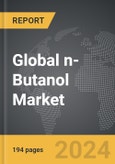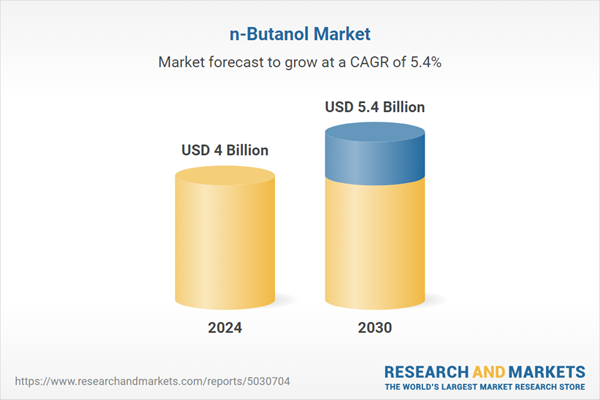Global n-Butanol Market - Key Trends & Drivers Summarized
What Is n-Butanol, and Why Is It Essential in Industrial Applications?
n-Butanol, a primary alcohol with a four-carbon structure, is a widely used industrial chemical known for its versatility. It is produced either through petrochemical processes from propylene or via fermentation of biomass. This solvent has significant applications in various industries, serving as an intermediate in the production of butyl acrylate, butyl acetate, glycol ethers, and plasticizers. Additionally, n-Butanol is used in coatings, adhesives, textiles, and personal care products. Its unique properties, such as its moderate solubility in water, high boiling point, and ability to mix with other organic solvents, make it indispensable for industrial formulations, especially in paints, coatings, and chemical manufacturing.How Is n-Butanol Transforming the Paints and Coatings Industry?
n-Butanol has become an integral component of the paints and coatings industry due to its superior solvent properties, improving the flow and gloss of coatings while reducing drying times. It serves as a key ingredient in the formulation of butyl acrylate, which is further utilized in the production of water-based paints and adhesives. As environmental regulations tighten around volatile organic compounds (VOCs), industries are increasingly adopting water-based formulations where n-Butanol plays a vital role in maintaining performance while reducing environmental impact. Furthermore, its application in automotive coatings and architectural paints is growing as industries seek better performance and longer-lasting finishes. With its ability to enhance the durability and adhesion of paints, n-Butanol continues to be a key enabler of innovation in high-performance coatings.What Emerging Trends Are Shaping the n-Butanol Market?
Several trends are shaping the n-Butanol market, particularly the increasing shift towards bio-based production methods. As industries and governments emphasize sustainability, bio-n-Butanol, produced from renewable sources like biomass, is gaining traction. This shift not only aligns with environmental goals but also reduces reliance on petroleum-based feedstocks. Another trend is the growing demand for n-Butanol in the construction and automotive sectors, where it is used in adhesives, sealants, and coatings to improve product longevity. Additionally, the rise of water-based adhesives and coatings as eco-friendly alternatives to solvent-based products is boosting the use of n-Butanol as a coalescing agent. The ongoing research into enhancing the biodegradability of n-Butanol-based products is also influencing its adoption in packaging and consumer goods, particularly as brands seek to meet the demands for sustainable packaging materials.What Is Driving the Growth of the n-Butanol Market?
The growth in the n-Butanol market is driven by several factors, including increasing demand from end-use industries such as paints and coatings, adhesives, and textiles, coupled with advancements in bio-based n-Butanol production. The growing construction and automotive industries are significant drivers of demand for n-Butanol-based products, especially in emerging markets where infrastructure projects and vehicle manufacturing are on the rise. Additionally, stricter environmental regulations that push for lower VOC emissions are encouraging industries to adopt water-based formulations, further boosting the demand for n-Butanol. The rising popularity of bio-based n-Butanol, driven by consumer and corporate sustainability goals, is also contributing to market expansion. Technological advancements in fermentation and bioprocessing methods are enhancing the production efficiency of bio-n-Butanol, supporting its increased adoption in eco-conscious markets. Lastly, the demand for higher-performance chemicals in industrial coatings, particularly in automotive and construction applications, continues to sustain the market's growth trajectory.Report Scope
The report analyzes the n-Butanol market, presented in terms of market value (USD). The analysis covers the key segments and geographic regions outlined below.- Segments: Application (Butyl Acrylate, Butyl Acetate, Glycol Ethers, Direct Solvents, Plasticizers, Other Applications).
- Geographic Regions/Countries: World; United States; Canada; Japan; China; Europe (France; Germany; Italy; United Kingdom; Spain; Russia; and Rest of Europe); Asia-Pacific (Australia; India; South Korea; and Rest of Asia-Pacific); Latin America (Argentina; Brazil; Mexico; and Rest of Latin America); Middle East (Iran; Israel; Saudi Arabia; United Arab Emirates; and Rest of Middle East); and Africa.
Key Insights:
- Market Growth: Understand the significant growth trajectory of the Butyl Acrylate Application segment, which is expected to reach US$2.2 Billion by 2030 with a CAGR of 6%. The Butyl Acetate Application segment is also set to grow at 5% CAGR over the analysis period.
- Regional Analysis: Gain insights into the U.S. market, valued at $1 Billion in 2024, and China, forecasted to grow at an impressive 8.4% CAGR to reach $1.2 Billion by 2030. Discover growth trends in other key regions, including Japan, Canada, Germany, and the Asia-Pacific.
Why You Should Buy This Report:
- Detailed Market Analysis: Access a thorough analysis of the Global n-Butanol Market, covering all major geographic regions and market segments.
- Competitive Insights: Get an overview of the competitive landscape, including the market presence of major players across different geographies.
- Future Trends and Drivers: Understand the key trends and drivers shaping the future of the Global n-Butanol Market.
- Actionable Insights: Benefit from actionable insights that can help you identify new revenue opportunities and make strategic business decisions.
Key Questions Answered:
- How is the Global n-Butanol Market expected to evolve by 2030?
- What are the main drivers and restraints affecting the market?
- Which market segments will grow the most over the forecast period?
- How will market shares for different regions and segments change by 2030?
- Who are the leading players in the market, and what are their prospects?
Report Features:
- Comprehensive Market Data: Independent analysis of annual sales and market forecasts in US$ Million from 2024 to 2030.
- In-Depth Regional Analysis: Detailed insights into key markets, including the U.S., China, Japan, Canada, Europe, Asia-Pacific, Latin America, Middle East, and Africa.
- Company Profiles: Coverage of players such as Andhra Petrochemicals Ltd, BASF Petronas Chemicals Sdn. Bhd., BASF SE, Cobalt Technologies, Inc., Dow, Inc. and more.
- Complimentary Updates: Receive free report updates for one year to keep you informed of the latest market developments.
Some of the 42 companies featured in this n-Butanol market report include:
- Andhra Petrochemicals Ltd
- BASF Petronas Chemicals Sdn. Bhd.
- BASF SE
- Cobalt Technologies, Inc.
- Dow, Inc.
- DuPont de Nemours, Inc.
- Eastman Chemical Company
- Green Biologics Ltd.
- Grupa Azoty S.A.
- KH Neochem Co., Ltd.
- Mitsubishi Chemical Corporation
- Oxea Corporation
- PetroChina Co., Ltd.
- Sasol Ltd.
- Sinopec Corp.
This edition integrates the latest global trade and economic shifts into comprehensive market analysis. Key updates include:
- Tariff and Trade Impact: Insights into global tariff negotiations across 180+ countries, with analysis of supply chain turbulence, sourcing disruptions, and geographic realignment. Special focus on 2025 as a pivotal year for trade tensions, including updated perspectives on the Trump-era tariffs.
- Adjusted Forecasts and Analytics: Revised global and regional market forecasts through 2030, incorporating tariff effects, economic uncertainty, and structural changes in globalization. Includes historical analysis from 2015 to 2023.
- Strategic Market Dynamics: Evaluation of revised market prospects, regional outlooks, and key economic indicators such as population and urbanization trends.
- Innovation & Technology Trends: Latest developments in product and process innovation, emerging technologies, and key industry drivers shaping the competitive landscape.
- Competitive Intelligence: Updated global market share estimates for 2025, competitive positioning of major players (Strong/Active/Niche/Trivial), and refined focus on leading global brands and core players.
- Expert Insight & Commentary: Strategic analysis from economists, trade experts, and domain specialists to contextualize market shifts and identify emerging opportunities.
Table of Contents
Companies Mentioned (Partial List)
A selection of companies mentioned in this report includes, but is not limited to:
- Andhra Petrochemicals Ltd
- BASF Petronas Chemicals Sdn. Bhd.
- BASF SE
- Cobalt Technologies, Inc.
- Dow, Inc.
- DuPont de Nemours, Inc.
- Eastman Chemical Company
- Green Biologics Ltd.
- Grupa Azoty S.A.
- KH Neochem Co., Ltd.
- Mitsubishi Chemical Corporation
- Oxea Corporation
- PetroChina Co., Ltd.
- Sasol Ltd.
- Sinopec Corp.
Table Information
| Report Attribute | Details |
|---|---|
| No. of Pages | 194 |
| Published | December 2025 |
| Forecast Period | 2024 - 2030 |
| Estimated Market Value ( USD | $ 4 Billion |
| Forecasted Market Value ( USD | $ 5.4 Billion |
| Compound Annual Growth Rate | 5.4% |
| Regions Covered | Global |









